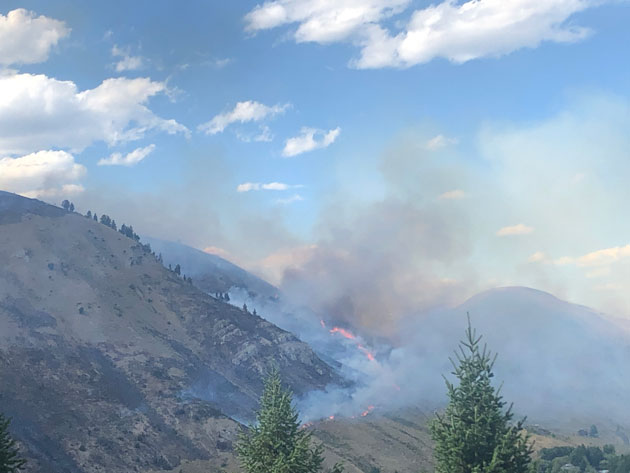As high-pressure was building a semi-permanent home over the Western United States during the first couple of weeks in August, temperatures were heating up, as it often does this time of year. Very warm temperatures and little to no precipitation resulted in a rapidly developing and dangerous fire season across the Western United States.
Around Jackson Hole, WY vegetation dried out rapidly during the first few weeks of August, elevating the fire danger to “Very High”, where it has remained since late August.
Only a few lightning strikes from isolated thunderstorms were noted the first half of this month. Nevertheless, it only takes one lightning strike. It only takes one improperly extinguished campfire. It only takes one dumbass with fireworks. Or, as we saw last year on September 1st on Saddle Butte, one errant Mylar balloon hanging up in a power-line, to set things ablaze.

Natural vs. Human Caused
According to the U.S. Forest Service, and a Smokey the Bear PSA, 9 out of 10 forest fires are caused by humans. Of the 10 fires that Teton Interagency Fire in western Wyoming has reported this summer so far, 7 of those were human caused, 3 were lightning caused.
As of the end of August there were 179 abandoned or unattended campfires found in Grand Teton National Park and on the Bridger-Teton National Forest. That is just unacceptable.
It is true that many of largest conflagrations throughout the West in recent years were not ignited by Mother Nature. However, the weather is a major contributor to fire potential.
The poorly maintained power-lines that sparked what was ironically called the “Camp Fire” in northern California in 2018, destroying the town Paradise, is an example of a human caused wildfire. The Roosevelt Fire that destroyed homes in Hoback Ranches in September 2018 was also a human caused conflagration.
Lightning is rare in Northern California, but some of the larger fires this year were started by lightning strikes, then blown to enormous proportions by strong winds.

Wind Hastens Fire
Hot and dry weather alone is not all that is required for big fires to erupt. That certainly helps, but the common denominator for large fire growth is wind. Fire smoldering in the duff or in an old fire ring, can be instantly brought back to life with a little wind. Continuous strong winds can fan and spread the flames in a very fast and efficient manner.
In the almost 40 years that I have lived in Jackson Hole, I have witnessed some big fires, all of which got huge because of the wind driving their growth. It is an impressive force of nature to observe a wildfire once the wind gets behind them.
The first big fire I witnessed, up close and personal while working as a Ranger in Grand Teton National Park, was the Beaver Creek Fire near Taggart Lake in August of 1985. That was started by lightning and was supposedly extinguished. Supposedly. High winds brought that one back to life and it made a run to the north, destroying some cabins at the Climbers Ranch.
Everyone has heard tale of the big Yellowstone fires during the Summer of 1988 encompassing over 800,000 acres or one-third of Yellowstone Park. These fires were primarily a series of lightning caused fires that began in July and were not suppressed, initially. Wind began growing some of these fires to unmanageable proportions through August and into September. They ran unabated until it finally snowed on September 11th.

The Antelope Flats Fire that burned down the historic Pfeiffer Homestead in 1994 and the Alder Fire in 1999 that nearly torched Jenny Lake Lodge were other notable fires that slipped out of our control, due to wind.
More recently, around the southern end of Jackson Hole, many of us can recall the Green Knoll fire in 2001 and the Horsethief Fire in 2012. the Horsethief Fire almost pushed its way over Snow King Mountain. A few degrees difference in wind direction and that fire could have easily rolled into downtown Jackson. Both of these fires were human caused.
Be Careful Out There
There are many more fire stories to be told, but I think you get the idea. From now until it snows, wildfires will likely be a threat.
As Smokey the Bear likes to say, “Only YOU can prevent forest fires”. That’s true, we can help prevent human caused fires by heeding the fire restrictions and foregoing the campfire experience, for instance.
Unfortunately, we can’t prevent lightning caused fires from starting and we can’t prevent the wind from blowing, and that is when fires can quickly get out of our control.
Jim is the chief meteorologist at mountainweather.com and has forecast the weather in Jackson Hole and the Teton Range for the last 29 years.
NOTE: This article originally appeared in the Jackson Hole News & Guide’s Mountain Weather column on August 26th, 2020.

